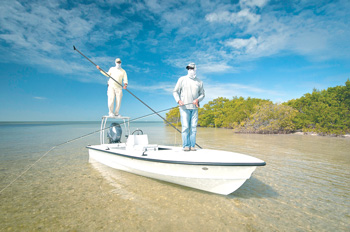Push poles: flat out essential

Rusty chinnis | SUN
Push poles give anglers stealthy
access to some very shallow water.
Push poles are as essential as rods and reels to anglers who stalk the flats. They have evolved from wooden poling oars hewn from solid timber to technological wonders of carbon fiber, Kevlar and graphite. In the early years of flats fishing, short poles were all that were needed as anglers hunted fish in shallow waters poling from the deck of their boats.
As flats boats evolved, elevated platforms allowed anglers to peer into deeper water, requiring longer poles to reach the bottom. Long wooden poles were too heavy and cumbersome, and anglers searched for lighter poles to propel them across the flats.
Tubular aluminum and fiberglass poles were developed, with fiberglass becoming the material of choice. Technological advances in rod design shifted from fiberglass to graphite, and it wasn't long before graphite push poles began replacing fiberglass. Graphite is light, causes the angler to expend less energy and allows a skiff to be poled faster.
This material is able to store more energy under a load, giving it a much faster recovery rate that puts energy into propelling the boat. Fiberglass poles have a lot of flex and recover more slowly. Graphite poles can be made stiff with much less material, creating a lighter, more dynamic product.
Initially, these new poles were crafted of pure graphite, but due to the cost and problems with breakage, designers innovated by blending graphite with fiberglass. The new push poles incorporated the strength of fiberglass with the lightness and dynamics of graphite. It also lowered the price point of the pole.
Guides and anglers now have the option of purchasing push poles manufactured from graphite, graphite/fiberglass composite, pure fiberglass or a mixture of the sections. The newest lines are being manufactured with cutting edge materials including Kevlar and carbon fiber, incorporating techniques that allow them to be made strong without fiberglass.
One of the most respected designs on the market comes from Fibertex Supply in Corpus Christie, Texas. The company clais its Stiffy brand push poles are the strongest on the market. The shaft of the pole is wrapped with pre-impregnated, UV stable, epoxy tape in a proprietary manufacturing process.
The lay-up of the pole includes longitudinal layers, which are counter and multiple wrapped. The company controls the cure time of the process with tension and pressure to produce high response dynamics, giving the push poles a superior strength to weight ratio.
Stiffy makes a complete line of push poles including a 100 percenty fiberglass, an 80/20 hybrid that is 80 percent graphite and 20 percent fiberglass and its Stiffy graphite with a high gloss ribbed black epoxy finish which is 100 percent graphite. Its Hell's Bay Custom Graphite pole features a low gloss black epoxy finish.
The top of the line product, the Extreme, is constructed of the finest graphite available. The Extreme measures 1.25 inches and is extremely light. This is a pole for experienced flats anglers .
The points and forks of most major push poles do not vary significantly. Most are made from a specially formulated abrasion resistant plastic for longer wear. The majority of forks are a simple "Y" design.
A better option is a fork with a tapered mud bar that runs between the legs of the fork. The best are cupped, widen in the center for support, and are designed to shed mud better than standard forks. They allow the angler more latitude when poling over soft bottom, so less effort is expended pulling the pole out of muck. Anglers who pole over hard bottom can opt for a metal tip that screws into the end of the point. The tip grabs bottom, wears longer, and is easier to stake ouat.
The length of the push pole is best determined by the depth of the water generally encountered and the size of the angler's boat. Eighteen to 20 plus foot poles are most common. Push poles are one of the most important components of the modern flats boat.
There are a wide variety of push poles on the market for every budget. Check the warranty and make sure that you can get quick service if you ever need to repair or replace the pole. The most expensive poles can run well over $1,000, so it's a good idea to actually try a push pole before investing in one.

